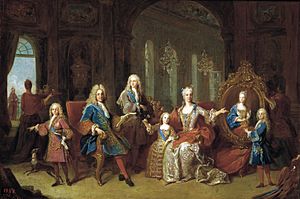The Family of Philip V (1743) facts for kids
Quick facts for kids The Family of Philip V |
|
|---|---|
 |
|
| Artist | Louis-Michel van Loo |
| Year | 1743 |
| Medium | Oil on canvas |
| Dimensions | 408 cm × 520 cm (161 in × 200 in) |
| Location | Museo del Prado, Madrid |
The Family of Philip V is a large painting by the French artist Louis-Michel van Loo. He finished it in 1743. This artwork shows Philip V of Spain and his family life-sized.
The painting looks like a fancy French baroque and rococo style. It shows the royal family in a made-up room. This painting is the most famous of three similar paintings. The others were made in 1723 by Jean Ranc and a smaller one in 1738.
Contents
About the Artist
Louis-Michel van Loo was a French painter born in 1701. He learned to paint from his father, Jean Baptiste van Loo. His father worked in Rome and Turin, supported by a prince.
Van Loo became the official painter for the Spanish royal court in 1737. He took over from another artist, Jean Ranc. He worked for the House of Bourbon in Spain until 1752. He was the main painter for Philip V's son, Fernando VI. Van Loo left Spain in 1757 and went back to France. Some art experts say that Dutch art also influenced his work. His younger brother, Charles Amédée Philippe van Loo, was also a successful painter. He even painted Empress Elizabeth of Russia.
What the Painting Shows
Today, The Family of Philip V is kept at the Museo del Prado in Madrid, Spain. This painting shows how strong the House of Bourbon became when Philip V became king in 1700.
The Royal Family
The king, Philip V, is in the middle of the painting. He sits next to his second wife, Elisabeth Farnese. Her arm is near a crown, which shows how much power she had.
To the left of the king is his youngest son with his first wife, Ferdinand. At the time the painting was finished, Ferdinand was the Prince of Asturias, meaning he was next in line for the throne. The Princess of Asturias, Barbara of Portugal, sits next to Philip V's oldest daughter, Maria Anna Victoria. Maria Anna Victoria had married Barbara's brother in 1729. This was part of a special double marriage deal between Portugal and Spain.
The children of Philip V and Elisabeth Farnese are in the center of the group. Between the king and queen is their youngest son, Cardinal Infante Louis. He later became the Count of Chinchón. To the queen's right is Infante Philip. He later became the Duke of Parma. He stands above his wife, Louise Élisabeth of France. She was the daughter of the French king, Louis XV.
Two young women stand above Louise Élisabeth. They are the younger daughters of Philip V and Farnese. These are Maria Teresa Rafaela and her younger sister Maria Antonia. Maria Teresa Rafaela married Louise Élisabeth's brother in 1745. Maria Antonia Fernanda married the future King of Sardinia in 1750.
On the far right, you can see Maria Amalia of Saxony. She is sitting next to her husband, Charles. At that time, Charles was the king of Naples and Sicily. He later became the king of Spain. The couple was in Naples when the painting was made. They returned to Spain when Ferdinand VI died in 1759.
Details in the Painting
The painting shows many rich materials. There are jewels, fancy fabrics, and bright colors. This was new for Spanish paintings, which used to be dark and serious. It was a nod to the Flemish school of painting.
A large, red curtain hangs from the ceiling, partly hiding a balcony. On this balcony, a band is playing music. The people in the painting are in a big room that opens up to a garden outside.
People in the Painting

- Mariana Victoria of Spain, Princess of Brazil (1718-1781). She later became the Queen of Portugal.
- Barbara of Portugal, Princess of Asturias (1711-1758). She later became the Queen of Spain.
- Ferdinand, Prince of Asturias (1713-1759). He later became the king of Spain.
- King Philip V (1683-1746).
- Cardinal Infante Louis (1727-1785). He later became the Count of Chinchón.
- Queen Elisabeth (Isabel) (1692-1766).
- Infante Philip (1720-1765). He later became the duke of Parma.
- Louise Élisabeth of France (1727-1759). She later became the duchess of Parma.
- Infanta Maria Teresa (1726-1746). She later became the dauphine of France.
- Infanta Maria Antonia (1729-1785). She later became the queen of Sardinia.
- Maria Amalia of Saxony (1724-1760). She later became the Queen of Spain.
- Charles, King of Naples (1716-1788). He later became the King of Spain.
- Infanta Isabella (1741-1763). She later became the archduchess of Austria.
- Maria Isabella Anna of Naples and Sicily (1743-1749). She died when she was very young.
See also
 In Spanish: La familia de Felipe V (Van Loo) para niños
In Spanish: La familia de Felipe V (Van Loo) para niños


